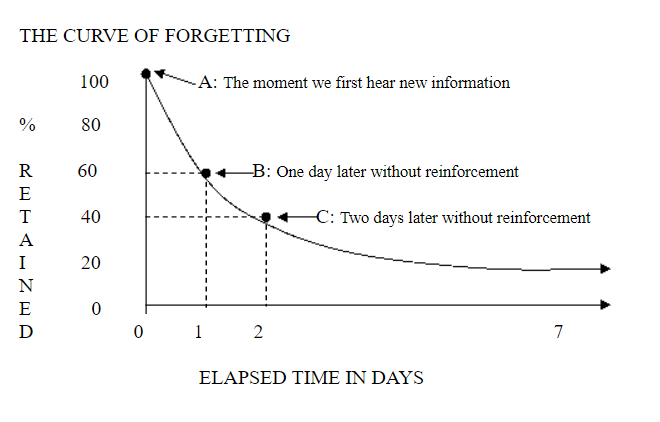Let’s just get this part out of the way first, shall we? No, you shouldn’t be studying on a beach with a mojito. Sorry.
But we understand the temptation. The flexibility of being able to study anywhere, at any time is one of the biggest benefits of online learning. But to succeed as a student, we need to recognize that online learning comes with some challenges as well.
To help our students prepare for these challenges, we’ve put together some information and tips about studying and learning online. Maybe you haven’t really studied for anything since high school or college. Or perhaps this will be your first experience learning outside of a traditional classroom. You might spend all day on the computer, but between the emails, social media, and home life, you have no idea how you will remember any of this!
We’re tackling these online learning challenges in this two-part blog series:
Part 1: In this article, we’ll cover the science-y brain stuff, like how the human brain deals with digital information and the best ways to remember the material you’re studying. These are some tried and true methods that will help you make the most of your online education.
Part 2: In the next article, we’ll look at the roles your personal learning style and study environment play in learning and retention. Plus, we’ll cover a few tools that you may find helpful for studying online so you can set yourself up for success from the get-go.
With no further ado…on to the science-y brain stuff!
While every person is unique in how they learn and retain information, it’s important to note that research does agree on a few points when it comes to reading and studying. We don’t want to get too detailed about the science, but knowing a little about how your brain works with information, especially digital information, will help you move through your course more efficiently and retain more information at the end.
Digital Brain
As computers, smartphones, and technology continue to integrate themselves into more and more of our day-to-day life, our brains are adapting to help accommodate the massive amounts of information we are constantly receiving. Research shows that now, when we read anything, we are skimming the words. We are skimming through paragraphs. Our brains are working to find the main point of whatever we’re looking at…while filtering out anything unimportant.
(Did you read everything in the paragraph above? Or skim it for the main point?)
This happens with everything, from your daily newspaper to big hardback novels, work emails, blog articles, you name it. If you’re reading it, you’re likely skimming. And while this may be OK for a novel, a textbook, or a newspaper, it’s not OK for an online course: Most computer-based courses (definitely our AdjusterPro courses) have already done that work for you.
So while it seems simple, think about it before you sit down to learn. Recognize that your brain will want to skim through that information. Don’t let it. What’s in the course is all important stuff, no fluff. We promise!
It’s also worth noting that if you’re here, you are likely studying to be an insurance claims adjuster. That makes thoroughly reading and comprehending information even more important. Being an adjuster means paying attention to the small but vital details in a claim. Missing something can lead to mistakes that will get your claims kicked back to you, or negatively affect the policyholders and insurance companies who are depending on you.
Study Time vs. Break Time
There are a lot of differing opinions on the exact numbers, but the takeaway here is that your brain needs a break. You may need to experiment with the timing a bit, but research shows, at most, you should not study for more than an hour without a break.
AdjusterPro Tip: Our courses are organized into manageable modules to help create a natural cycle of work and breaks.
Two of the most popular approaches to studying are The Pomodoro Method and The Rule of 52/17.
The Pomodoro Method is performing focused work for 25 minutes, then taking a 5-minute break. Each 25-minute work session is called a ‘pomodoro.’ After completing four pomodoros, you take a longer 15-30 minute break.
The Rule of 52 and 17 is pretty self-explanatory. You put in 52 minutes of focused work and then follow it with a 17-minute break.
It may be tempting, especially if you have a hectic schedule, to sit down and power through for a few hours. Or maybe you “take a break” and then switch from your online class to your email, Facebook, or favorite sports or gossip website. That doesn’t count! You need to step away from the computer.
Force yourself to take a real break at least once an hour. Get up and move around. Make some tea. Grab some food. Go outside and walk for a few minutes. Shoot some hoops. But no matter what you do, you need to change your scenery. Your elementary teachers had this one right: a quick recess will recharge your focus and comprehension.
Retaining Information
Retaining and recalling information is the main challenge for every student of every age, and unfortunately, the computer has not helped us here either. Research shows we do not retain digital information as well as printed information. But there are some things we can do to help us remember.
1. Study the same material in multiple ways
Take notes. Make flashcards. Read aloud. Any time you translate words into a different medium—from online to print, from print to speaking — it helps solidify those pathways in your brain and you will remember it better. (This is why we have both audio and written information in our courses.)
Receiving and translating the same information in two different ways helps you retain it. Research also shows that explaining what you have learned to someone else greatly improves recall. So if you are struggling to understand and remember a concept or a definition, grab your spouse, your kid, even your dog and explain it to them. It sounds silly, but science shows it works!
2. Review the material the very next day
After you learn something new, try to review that information within 24 hours. This is based on a concept scientists have known about for a long time: The Forgetting Curve. First discovered in the 1800s, the Forgetting Curve is still widely used and highly regarded today.
The curve theory shows that within 24 hours of learning something new, you will forget 40%-60% of that information. But if you review it, even for just 5 minutes the next day, your retention rates skyrocket! (Use your flashcards and notes.) It can be challenging to do with a hectic schedule, but it will save you time in the end.

3. Don’t multitask!
One of the biggest advantages of learning online is also its biggest challenge. You may think you are still learning the information even though you’re checking emails and listening to the news and chatting with your wife, but science knows you aren’t. Research shows that multitasking interrupts the processing and absorption of knowledge into your brain. So if you aren’t really processing it, you probably won’t be able to recall it.
AdjusterPro Tip: Try to treat your online class just like you would a normal class. Close all other windows and programs on your computer. Put away your phone. Turn off the television and email/text notifications. If you have something that requires your urgent attention, make that time your ‘break.’
Sage on the stage…or lack thereof
Traditional classrooms offer a ‘Sage on the Stage.’ A teacher. A pro. An expert in the material who can help guide you, lead discussions, and answer questions. But online learning courses often lack the Sage, and this can have an intellectual and emotional effect on some learners. We often need help when we come across a concept we don’t understand.
AdjusterPro Tip: Join our Alumni group on Facebook! We have a wonderful group of past and current students who are supportive and eager to help the adjuster community.
Experts can explain things in different ways to help you understand the information. They repeat data throughout the classes to help you remember it. Additionally, good teachers ask questions and lead discussions that keep students engaged and focused. And sometimes, the great ones, do it all while being very entertaining.
There is no easy solution to the challenges presented by the lack of a Sage. Much like ‘digital brain’, simply being aware of the issue can help you overcome its effects.
Recognize when you need to reach out for help and don’t be afraid to do so. Take a break when you find yourself overwhelmed by the information and want to look to a teacher for assistance. Or contact us! Our team has created, written, taken, explained, and edited these courses. We know the information and would be happy to help.
So before diving head first into that next chapter or course, create a strategic plan for your work. Understand the challenges you might face and how to combat them. If you keep these brain basics in mind and make an effort to adjust your study habits accordingly, you’ll see great results and be on your way to a successful career as an insurance claims adjuster.
In part two of this series, Adam Gardiner covers questions about personal learning style, study environment, and what tools are available to help you stay focused. Read Succeeding as an Online Student: Part 2.



